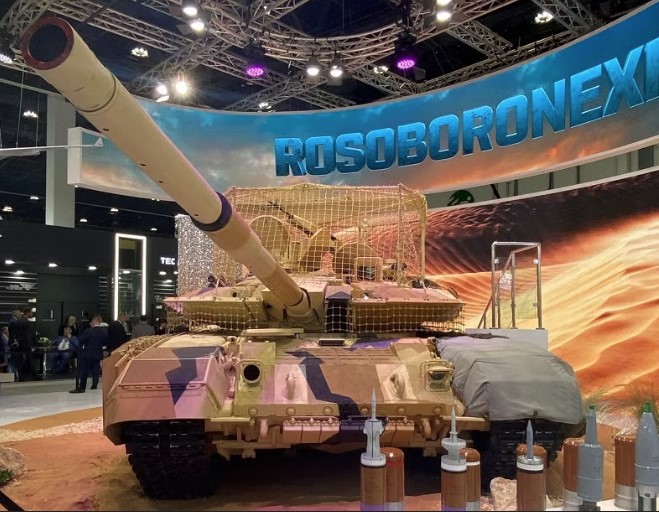Russia made a shocking and unusual move by sending one of its tanks, which it had only intended for display at an international arms show, directly into combat in Ukraine. Earlier this year, at the International Defense Exhibition (IDEX) in Abu Dhabi, Russia displayed a modern T-90MS tank. The Russian team painted the vehicle in desert camouflage to attract foreign buyers and showcase its latest armored technology.
Desert Tank Turns Battlefield Beast
But now, Defense Blog reported on September 14 that Russian forces sent the same tank back to Russia, repainted it in army green, and deployed it to the warfront in Ukraine. The tank manufacturer, UralVagonZavod, confirmed the transfer and said that it provided the tank “in nearly the same configuration as it had shown at the exhibition.” The company only changed its appearance by replacing the camouflage paint used for exhibitions with the standard military color used in actual warfare.
The T-90MS tank represents a modern version of the T-90 series. The manufacturer specifically designed it for export markets and equipped it with advanced protection, firepower, and optics. Normally, companies keep tanks like this for demonstration and marketing purposes. They are rarely, if ever, sent into battle. This deployment is a sign of how urgently Russia’s army needs combat-ready tanks due to severe battlefield losses.
Russia’s modern tank fleet in crisis — Kremlin resurrects 50-year-old T-72s for Ukraine war
The decision to send an exhibition tank to the front lines shows how stretched Russia’s military resources have become. This tank, once a showpiece, is now a frontline warrior in one of the world’s most intense ongoing conflicts.
Heavy Losses at the Front
Russia’s tank losses have been among the most devastating in the ongoing war in Ukraine. Independent intelligence groups tracking battlefield developments reported that Russia has lost at least 100 tanks in the Pokrovsk region alone over the past six months. In addition to these tanks, Russian forces have destroyed or rendered unusable more than 200 armored vehicles—including personnel carriers and infantry fighting vehicles.
These numbers show that Russia’s armored forces have weakened significantly. Tanks play a crucial role in ground warfare because they provide both firepower and protection for troops. Without enough tanks, Russia cannot launch large-scale attacks or hold defensive positions effectively.
Trump threatens NATO with ultimatum: no unity, no sanctions on Russia
The fact that Russia had to send a demonstration tank like the T-90MS to the front lines highlights how severe the shortage has become. Russia is now repainting tanks that it originally built to impress international buyers and sending them into dangerous battle zones.
Analysts suggest that battlefield tank depletion has forced Russia to pull equipment from reserve stockpiles and exhibition models. This also shows how the war has stretched Russia’s supply lines for military hardware over time. A tank remains a vital asset, and losing hundreds of them has created a crisis that Russia cannot solve without ramping up production or finding alternative equipment.
Tank Production Ramps Up Amid Urgent Needs
In response to these losses, Russia is increasing the production of tanks and other military equipment at a fast pace. Ukrainian military intelligence reports that Russia plans to produce nearly 250 new T-90M tanks by the end of 2025. Along with tanks, it aims to manufacture 2,500 missiles, 1,100 armored vehicles, 57 fighter jets, and over 360 artillery systems.
This boost in production shows how vital tanks remain to Russia’s war efforts. Even with heavy losses, Russia continues to prioritize the rebuilding of its armored forces. The T-90MS tank deployment is a temporary solution while new tanks are being produced.
The increased tank production also reflects broader military preparations. Tanks provide firepower, mobility, and protection, which makes them indispensable in modern warfare. A shortage of tanks can significantly limit a country’s ability to sustain attacks and defend key positions.
🔥 Ukrainian tank stuns Russian armor at point-blank range in Siversk showdown
The fact that Russia has resorted to deploying tanks originally meant for exhibitions sends a clear message about the scale of its battlefield challenges. Even as new tanks are being manufactured, the need for immediate reinforcements has pushed Russia to use every available armored vehicle—including display models like the T-90MS.
This situation marks a rare and powerful example of how prolonged warfare can force countries to rethink their military assets. The deployment of tanks like the T-90MS from arms exhibitions to actual combat zones is a clear sign of the pressures faced by Russia’s armed forces. With tank shortages becoming increasingly visible, the importance of armored units in ongoing military operations is more evident than ever before.
